
 | |
| Volume 1, Number 3 | May/June 1995 |
The following article should be regarded as a resource. It is a compilation of Biblical chronological data giving a continuous chronology for the second and third millennia B.C. It takes into consideration the most recent work in Biblical chronology, including my discovery of the missing thousand years in the present text of 1 Kings 6:1. It is the only Biblical chronology for these millennia which naturally harmonizes with a wide breadth of geophysical, archaeological and secular historical data. Older Biblical chronologies (such as are currently found in Bible encyclopedias, for example) are obsolete and seriously wrong in these two millennia. Anyone attempting to use them to harmonize Biblical and secular history will encounter endless frustration. (I speak from experience.)
A summary chart can be found at the end of the article. A copy of this chart taped to the inside cover of your Bible makes a handy study aid.
The historical narrative of the Bible which spans the second and third millennia B.C. seems to divide most naturally into two major periods, Proto-Israel and the Theocracy, with a third period, the Monarchy, beginning near the close of the second millennium.
Proto-Israel is the period of time during which the nation of Israel was in the making. It begins with the entrance of Abraham into Canaan, and ends with the birth of the nation of Israel at the time of the Exodus.
The duration of the Proto-Israel period is calculated as follows. Abraham entered Canaan at age 75 (Genesis 12:4-5). His son Isaac was born when he was 100 (Genesis 21:5). This gives the first 25 years of the Proto-Israel period. Isaac's son Jacob was born when Isaac was 60 years old (Genesis 25:26). When summed to the previous 25 years, this yields a total of 85 Proto-Israel years. Jacob and his family entered Egypt when he was 130 years old (Genesis 47:9). This gives 215 Proto-Israel years. The Exodus occurred after Israel had been in Egypt 430 years (Exodus 12:40-41). This gives a total length for the Proto-Israel period of 645 years.
This span of time should not be regarded as exact; there are a number of uncertainties. First, each of these numbers must be regarded as rounded, at least to the nearest whole number of years. This introduces a minimum of a half-year uncertainty in each. Computing the uncertainty in the sum using the square root of the sum of squares method gives approximately 1 year.[1] Thus, this consideration alone suggests we should regard the length of the Proto-Israel period to be, not exactly 645 years, but rather somewhere between 644 and 646 years.
Observe, however, that four of the five numbers (i.e., 75, 100, 60, 130, 430) which are used in this computation end in zero, and the remaining one ends in five. This suggests that these numbers may have been intended to be understood as rounded to the nearest decade or half-decade. To be on the safe side, I assume a rounding uncertainty of ±5 (i.e., plus or minus five) years on each of these numbers. This yields an uncertainty in the sum of about 11 years. The length of the Proto-Israel period must then be regarded as between 634 and 656 years.
The first four numbers comprising this sum are likely to seem incredible to some. These four numbers represent ages, and they are all unusually high by present-day norms. Abraham sets out on a new life at age 75, and fathers a son at age 100. Isaac, in turn, fathers twins at age 60, and Jacob stands before Pharaoh at age 130. But however unusual these numbers may seem, we have no objective grounds for modifying or rejecting them. There is no reason to believe the rate of human aging has always been as it is today. In fact, the cause of aging remains a complete mystery despite decades of intensive research. It is certainly theoretically possible for life spans to have been longer in the past. In the absence of contradictory evidence, the only reasonable procedure is to accept the clear witness of the text. Accordingly, I make no allowance in the estimated uncertainty of the duration of the Proto-Israel period for any supposed inflation of these numbers.
A final consideration affecting this calculation is the interpretation of the text in regard to the "430" year figure. The Masoretic Text of Exodus 12:40-41 seems clearly to imply that this 430 years was the duration of the Israelites' stay in Egypt alone. In the Septuagint, however, verse 40 reads "And the sojourning of the children of Israel, while they sojourned in the land of Egypt and the land of Chanaan, was four hundred and thirty years."[2] If one follows this reading the Proto-Israel period is shortened considerably. At the present time a number of geophysical and historical evidences (e.g., archaeological and radiocarbon synchronisms with Joseph's famine, the timing of the construction of the pyramids in Egypt, and the Genesis 13:10 synchronism discussed in a previous issue[3]) seem clearly to exclude such shortening.
The approximate absolute dates for the beginning and ending of the Proto-Israel period are obtained as follows. We begin with the accession date of Rehoboam, Solomon's son, which is given by Thiele[4] as 931/930 B.C. I assign an uncertainty of ±10 years to this starting date based upon the range of scholarly opinions I have seen regarding it. To this date we must add the length of Solomon's reign, which is given as 40 years in 1 Kings 11:42 and 2 Chronicles 9:30. We must then subtract 4 and add 1,480[5] years to take us to the date of the Exodus (1 Kings 6:1). This computes to 2447 B.C. Allowing 5 years uncertainty in the length of Solomon's reign, a 0.5 year uncertainty in the timing of the commencement of the building of the temple, and 5 years uncertainty in the 1480 year figure gives a total uncertainty in the date of the Exodus of about 12 years. Thus, I compute the date of the Exodus (and end of the Proto-Israel period) to fall somewhere between 2459 and 2435 B.C.
The date of the beginning of the Proto-Israel period is easily obtained by adding the duration of this period (645±11 years, computed above) to its ending date. This yields 3092±16 B.C.
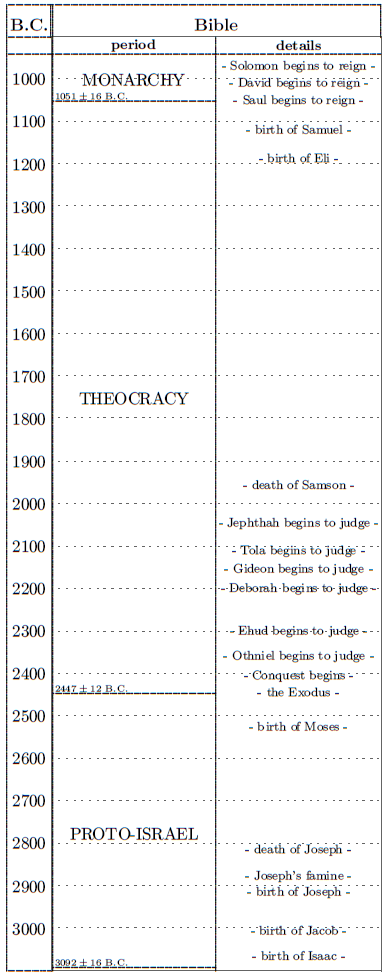 |
"Theocracy" means "the rule of God." This period extends from the birth of the nation of Israel at the Exodus, through to the rejection of God as king (1 Samuel 8:7) and choice of Saul.
The span of time involved in the Theocracy period is calculated as follows. It is the time between the Exodus and Solomon's fourth year (1480±5 years) minus the time from the accession of Saul to Solomon's fourth year. This later time is computed from three Biblical numbers. The first is the length of Saul's reign. The tens digit for this number is, unfortunately, missing from all extant ancient manuscripts of 1 Samuel 13:1, so we are left with only 2 years for the length of Saul's reign. However, Acts 13:21 suggests that this number should be around 40 years. I will work with the figure of 40, and assign an uncertainty of ±10 years to cover the textual uncertainty here. The second number is the length of David's reign. It is given in 2 Samuel 5:4 as 40 years; I will use 40±5. The third number is the time from the beginning of Solomon's reign to the commencement of the building of the temple; I will use 4±0.5 as previously. The final result, when all of these numbers are properly combined is 1,396±12 years.
The absolute date for the termination of the Theocracy period is, once again, computed backwards from the accession of Rehoboam. It is [(931±10 B.C.) + (40±5 years for the reign of Solomon) + (40±5 years for the reign of David) + (40±10 years for the reign of Saul)]. This gives 1051±16 B.C.
The Monarchy period extends from the beginning of the reign of Saul to the end of the reign of Zedekiah (2 Kings 25:6) in ca. 586 B.C. Since we are only interested in the second and third millennia B.C. in this study I will hold discussion of this final date.
The time chart at left summarizes the foregoing results. It shows the Biblical periods we have outlined above, together with a selection of Biblical events in the rightmost "details" column, placed at their appropriate dates. These dates are easily calculated from the Bible given the framework presented here.[6]
While the computations required to produce this chart are somewhat mundane, the result is truly extraordinary. A routine 3σ precision of ±16 years for dates in the 3000 B.C. range is outstanding and unparalleled by other historical chronologies at present. ◇
I decided to put this issue's quiz into the form of a crossword puzzle. This is an open-newsletter quiz. Almost all of the answers can be found in the first two issues of The Biblical Chronologist, number 5 being the main exception. The correct answers can be found by scrolling to the bottom of this web page – but no peeking until you are finished. Drop me a postcard and let me know how you scored. Perhaps I'll publish a class average next issue.
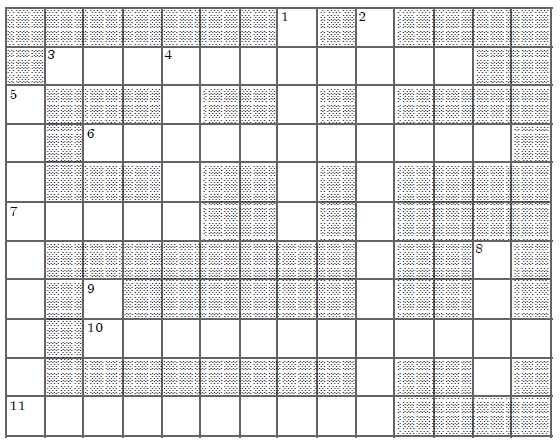 |
What Lisan means.
Historical actuality.
What Paul told Christians not to argue over.
One thing flood waters can do.
Name of an archaeological period meaning "new stone age."
A branch of theology devoted to the defense of the divine origin and authority of Christianity.
The size of the Biblical chronology error which resulted from a tiny copy error in 1 Kings 6:1.
What the region around the Dead Sea is like today.
Meaning "Before Christ."
Archaeological period ending around 3600 B.C. in Palestine.
What this newsletter is all about.
Last issue we began a discussion of the importance of Biblical chronology. I would like to finish this discussion this issue.
I stated last issue that Biblical chronology is important because our ability to defend the truth of Christianity hinges upon it. This relationship is succinctly summarized by the statement, "Biblical chronology is foundational to apologetics."
Biblical chronology is foundational to apologetics because wrong Biblical chronology yields a failed apologetic. In the current lesson I would like to show why this is the case. The argument leading to this conclusion involves three simple premises:
Wrong Biblical chronology yields wrong Biblical history.
Wrong Biblical history yields a loss of Biblical historicity.
A loss of Biblical historicity yields a failed apologetic.
Last issue we looked at the last of these three premises. We saw the critical role played by the question, "Is the Bible a basically reliable historical document?" in the defense of the truth of Christianity. We saw that if this question could be answered, "No, it is not a basically reliable historical document," then the defense of the truth of Christianity would collapse. In other words, we showed that premise 3 is true – a loss of Biblical historicity yields a failed apologetic.
The second premise above is almost tautological and requires little elaboration. Recall that historicity means historical actuality – it means true history, or what really took place. Wrong history means an inaccurate account, or a misrepresentation of what really took place. Clearly, when what really took place is misrepresented, a loss of historical actuality is the result. Therefore, wrong Biblical history yields a loss of Biblical historicity.
It is only the first premise, then, which requires further discussion, and it does not require very much discussion.
The reason wrong Biblical chronology yields wrong Biblical history is because chronology is an integral part of history, and the whole cannot be right unless all of its parts are right.
Last issue I used the well-worn phrase "chronology is the backbone of history" to introduce the idea of the close relationship which exists between chronology and history. We all know what backbones do, of course. They provide the basic frame from which the rest of the organism is built. Remove the backbone, and an organism will lose its form. It will become an amorphous blob, like an amoeba or a jellyfish, with no rigid linkage between its component parts.
Chronology plays this kind of role with history. True history consists of a myriad of facts (real-life events) arranged in a completely unique order in time. To recite true history we must tell what really happened in the past. To accomplish this it is not enough to tell what events took place – we must also tell when these events took place. Without this chronological information, history loses its form and collapses into non-history.
To illustrate, consider the following scenario. Suppose we have the following three historical facts, given in correct chronological order as they occurred one evening:
I ate a sandwich.
I went to bed.
My tent collapsed.
What happens to this snatch of history if we get its chronology wrong? Suppose we just get the order in which these events took place mixed up. What are the possible outcomes?
From elementary mathematics we know that three different things can be arranged in three factorial or six different ways. Thus, there are six possible stories which can be told with these three facts when chronological ordering constraints are removed. They are: 1. I ate a sandwich. I went to bed. My tent collapsed. 2. I ate a sandwich. My tent collapsed. I went to bed. 3. My tent collapsed. I ate a sandwich. I went to bed. 4. My tent collapsed. I went to bed. I ate a sandwich. 5. I went to bed. I ate a sandwich. My tent collapsed. 6. I went to bed. My tent collapsed. I ate a sandwich.
Each story is different. Each suggests different spatial arrangements of me, my tent and the sandwich. Each suggests different causal relationships between the three events. None of the stories is intrinsically impossible. Yet only the first corresponds to true history – the other five are all fictitious.
We see immediately that historical facts do not reveal true history in and of themselves. Indeed, historical facts can be used to tell all sorts of fictions. Historical facts tell history only when they are placed in correct temporal relationship to one another. Thus chronology is an integral part of history, and wrong chronology necessarily yields wrong history. Premise 1 – wrong Biblical chronology yields wrong Biblical history – is seen also to be true.
The logical sum of these three premises is our desired conclusion: "wrong Biblical chronology yields a failed apologetic."
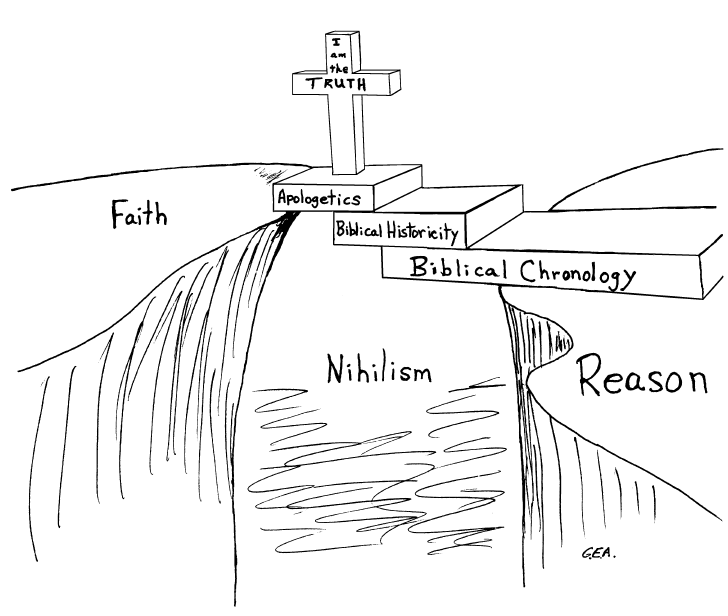 |
I have tried to illustrate my thoughts in this regard in the sketch above. I picture Biblical Chronology as a foundation block extending from the heights of Reason toward the heights of Faith. In itself it cannot span the chasm between, but upon it is laid another foundation block called Biblical Historicity. It also is too short to span the remaining gap, but upon it a final block called Apologetics is laid. This final block is able to bridge the remaining distance, thereby linking Faith and Reason and completing the foundation of Truth. If Biblical Chronology is removed or broken, the remainder is lost into the chasm called Nihilism. ◇
I continue to pursue the nature and date of Noah's Flood.
I ended last issue with a figure, reproduced below, summarizing my proposed relationship between the chronologies of Scripture, Palestine, and Egypt near 3500 B.C. For the past two months I have turned my attention to the chronology of Mesopotamia, asking the question, "Can a cultural break or any other evidence of the Flood be discerned in this region near 3500 B.C.?"
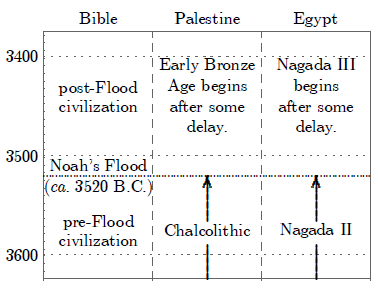 |
The chronology of Mesopotamia is considered to be securely established only back to the middle of the second millennium – two thousand years short of our current interest. From the middle of the second to the middle of the third millennium three possible chronologies exist, the highest and lowest of which differ by 200 years. The chronology of the fourth millennium is even more uncertain – errors of 500 years in absolute dates for this millennium do not seem impossible to me at the present time.[7] The historic period (during which time written sources exist to aid in chronological reconstruction) only begins around 3000 B.C.; there presently appears no possibility of a historical chronology of Mesopotamia extending back into the fourth millennium.
One might hope to find definitive radiocarbon results to reduce the uncertainty in the fourth millennium chronology. Unfortunately, there appears to be few radiocarbon dates available for this area during this millennium – a reminder, once again, that we are researching at the frontier of chronology.
The present "standard chronology" (which must not to be equated with the unknown, true chronology) of Mesopotamia from 4500 to 2500 B.C. is shown in Figure 3.[8] It places the boundary between Middle and Late Gawra in the north, and Middle and Late Uruk in the south, at 3500 B.C. However, if we allow 500 years uncertainty in the dates of these boundaries, then it is possible for Noah's Flood to have taken place anywhere from the late Ubaid to mid Jamdat Nasr.
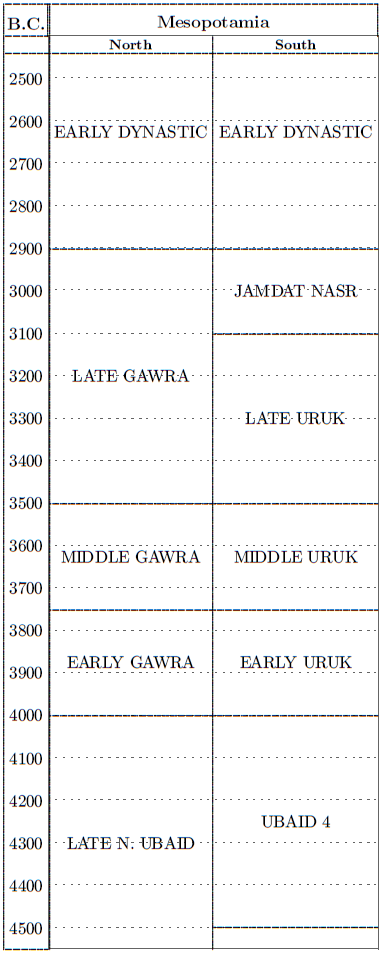 |
The late Ubaid is somewhat interesting because of Sir Leonard Woolley's discovery in the 1920's and 30's of a flood layer at Ur. It is fairly well known that Woolley identified this eleven foot layer of silt, which lay near the base of the thick archaeological strata at Ur, with "Noah's Flood." As I started this search, I came upon two of Woolley's classic books, Ur of the Chaldees and Spadework in Archaeology. Woolley reported his discovery of this layer in both of these volumes.
Apparently, many Christian's jumped at Woolley's discovery, regarding it as "proof" of Noah's Flood when it was first announced. Unfortunately, the full nature of Woolley's claims was apparently not understood by most of these Christians. From what Woolley has written it is clear that he did not believe the Biblical record of the Flood was an accurate historical account. Rather, he supposed that it reflected merely one tradition of a big flood which had happened in Mesopotamia long before the Bible had ever been written. He felt the Biblical account of Noah's Flood was essentially a myth with but a kernel of truth behind it.
Woolley did not pretend to be demonstrating Biblical historicity by his discovery; indeed, he began with the assumption of non-historicity and felt his discovery validated that assumption. Here, for example, is how Woolley summarized his discovery at Ur:
In the lowest levels of potsherds the Erech [same as Uruk above] ware was mixed with and finally replaced altogether by al 'Ubaid [same as Ubaid above] pottery, hand-made without the wheel, the product of the early and still barbarous villagers who first settled at Ur. Then we came to the flood deposit, eleven feet of clean silt, disturbed only by a few graves dug into it by the late al 'Ubaid people whose pottery we had found; silt left piled up against the mound whereon the primitive town had stood by an inundation that must have overwhelmed all the low-lying villages of the river valley and destroyed what for those people was the world. Under the eleven-foot stratum lay the ruins of the houses in which had lived the antediluvian inhabitants of the Lower Town; they had, we may suppose, taken refuge on the mound, the Inner City, and from its walls watched their homes disappear beneath the muddy waters of the flood. This was the flood, coming in the latter part of the al 'Ubaid period, which the ancient Sumerians regarded as the outstanding disaster in their country's history, and out of the historic fact grew the legend which in course of time the Hebrew people incorporated in their own sacred writings and handed on to us today, the story of Noah's Flood.[9]
One of the consequences of such an attitude toward Biblical history is that rigorous, objective investigation is lost. One cannot expect a legend to stand up to the rigors of critical historical investigation, and what constitutes the kernel of truth around which a legend is built is purely a matter of subjective opinion. Consequently, Woolley did not critically evaluate his flood evidence to see if it truly matched the Biblical narrative of Noah's Flood. It was enough for Woolley that he had found any sort of flood evidence – this was readily molded into the requisite kernel of "truth."
But let us not be side-tracked by Woolley's philosophy, theology, or methodology. We are only interested in his scientific data, which are principally these: 1. the existence of a silt layer, eleven feet thick, and 2. which was deposited at Ur in the latter part of the Ubaid period in Mesopotamia.
Eleven feet of silt is clear evidence of a flood, and such a thick layer of silt certainly suggests a big flood. Also, this layer appears to be unique. Woolley dug through quite a long period of history at Ur, at least three thousand years worth. Yet this is the only flood layer of any sort which he reported in his two books – apparently, it is the only one he found. Finally, as indicated above, the possibility that this layer may date to our expected Flood date ( ca. 3520 B.C.) cannot be ruled out.
This leads to the question, "Is it possible that Woolley's identification of this flood evidence with the Flood of Noah was, in fact, correct?"
There seem serious difficulties with such a suggestion at present, and indeed, it has generally been repudiated by liberal and conservative alike. For example, the accomplished archaeologist, G. Ernest Wright, wrote some time ago,
This archaeologist [Woolley] discovered a water-laid deposit at Ur, some 10 feet (3 meters) thick, dating from the middle [?] of the Ubaid period of the 4th millennium B.C. This, he claimed, was conclusive evidence of the Flood. Yet in only two of the five pits that Woolley dug to virgin soil did he find the "flood" layer. This evidence suggests that the flood in question did not cover the whole city; and we know that it made no break in the continuity of culture there.Other cities in the Mesopotamian river valley, notably Kish, Fara, and Nineveh, also show flood layers, though none of them can be closely correlated in time. On the other hand, the excavators have found no such layer in Gilgamesh's own city of Erech (Warka). In other words, the Mesopotamian "flood" evidence is that of purely local inundations of the Tigris and the Euphrates.[10]
It seems that further investigation of Woolley's claim is only called for in the interest of leaving no stone unturned. What seems likely to be more profitable is time spent collecting and analyzing available radiocarbon dates from the fourth millennium B.C. in Mesopotamia to see what further constraints can be imposed on its chronology at present.
I have so far been unable to find anything like the cultural break apparent in Palestine at the close of the Chalcolithic in either the late Ubaid or Uruk periods. Whether something will come to light upon closer scrutiny remains to be seen. ◇
The Biblical Chronologist is a bimonthly subscription newsletter about Biblical chronology. It is written and edited by Gerald E. Aardsma, a Ph.D. scientist (nuclear physics) with special background in radioisotopic dating methods such as radiocarbon. The Biblical Chronologist has a threefold purpose: to encourage, enrich, and strengthen the faith of conservative Christians through instruction in Biblical chronology, to foster informed, up-to-date, scholarly research in this vital field within the conservative Christian community, and to communicate current developments and discoveries in Biblical Chronology in an easily understood manner. The Biblical Chronologist (ISSN 1081-762X) is published six times a year by Aardsma Research & Publishing, 412 N. Mulberry, Loda, IL 60948. Editor and Writer: Gerald E. Aardsma, Ph.D. Copyright © 1995 by Aardsma Research & Publishing. Photocopying or reproduction strictly prohibited without written permission from the publisher.
|
^ One can get quite elaborate when dealing quantitatively with uncertainties in chronological computations. In the vast majority of cases, however, a precise error estimate is not needed, and a simple, uniform procedure is more desirable. I use what approximates to 3σ error bars in an effort to define a range of dates (i.e., a time-bracket) in which the true date in question can almost certainly be found. It is most convenient to round all computed dates and time spans to the nearest year only, and then display these results together with their computed 3σ uncertainty. This avoids the appearance of exaggerated precision, and retains all digits for use in subsequent computations.
^ Sir Lancelot C. L. Brenton, The Septuagint Version: Greek and English (Grand Rapids: Zondervan Publishing House, 1970), 86. Some have marshaled Galatians 3:17 in defense of this reading as well.
^ "Mount Sodom Confirms Missing Millennium", The Biblical Chronologist, vol. 1, no. 1, (January/February 1995): 1-4.
^ Edwin R. Thiele, The Mysterious Numbers of the Hebrew Kings (Grand Rapids: Academie Books, Zondervan Publishing House, 1983), 217.
^ See Gerald E. Aardsma, A New Approach to the Chronology of Biblical History from Abraham to Samuel, 2nd ed. (412 N. Mulberry, Loda, IL: Aardsma Research & Publishing, 1995) for details of this number.
^ Most of the dates in this column can be found in Table 4.1 of my book, A New Approach to the Chronology of Biblical History from Abraham to Samuel, referenced previously.
^ This assessment is based upon a survey of the published literature; it does not include any first-hand work on my part with available radiocarbon data.
^ Edith Porada, Donald P. Hansen, and Sally Dunham, "The Chronology of Mesopotamia, ca. 7000-1600 B.C.," in Chronologies in Old World Archaeology, volume 2 (Chicago: The University of Chicago Press, 1992), 96,98.
^ Sir Leonard Woolley, Spadework in Archaeology (New York: Philosophical Library, 1953), 105-106.
^ G. Ernest Wright, "The Flood," The Encyclopedia Americana – International Edition (Danbury, Connecticut: Grolier Incorporated, 1993), 415.